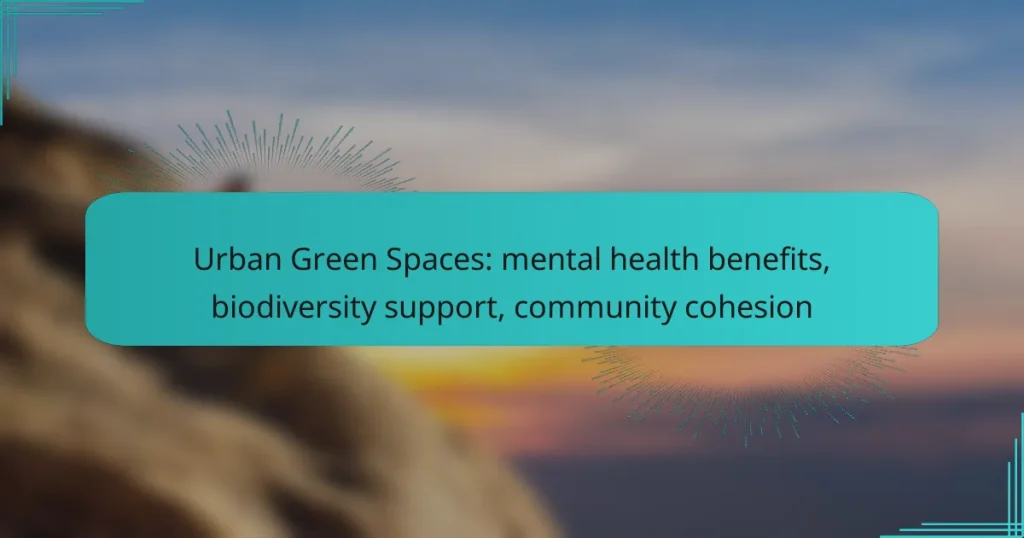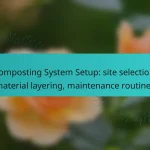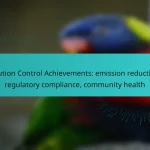Urban green spaces are essential for promoting mental health, enhancing biodiversity, and fostering community cohesion. They provide a refuge from the stresses of city life, support diverse ecosystems, and serve as gathering places that strengthen social ties among residents. By integrating nature into urban environments, these spaces contribute to the overall well-being of individuals and communities alike.
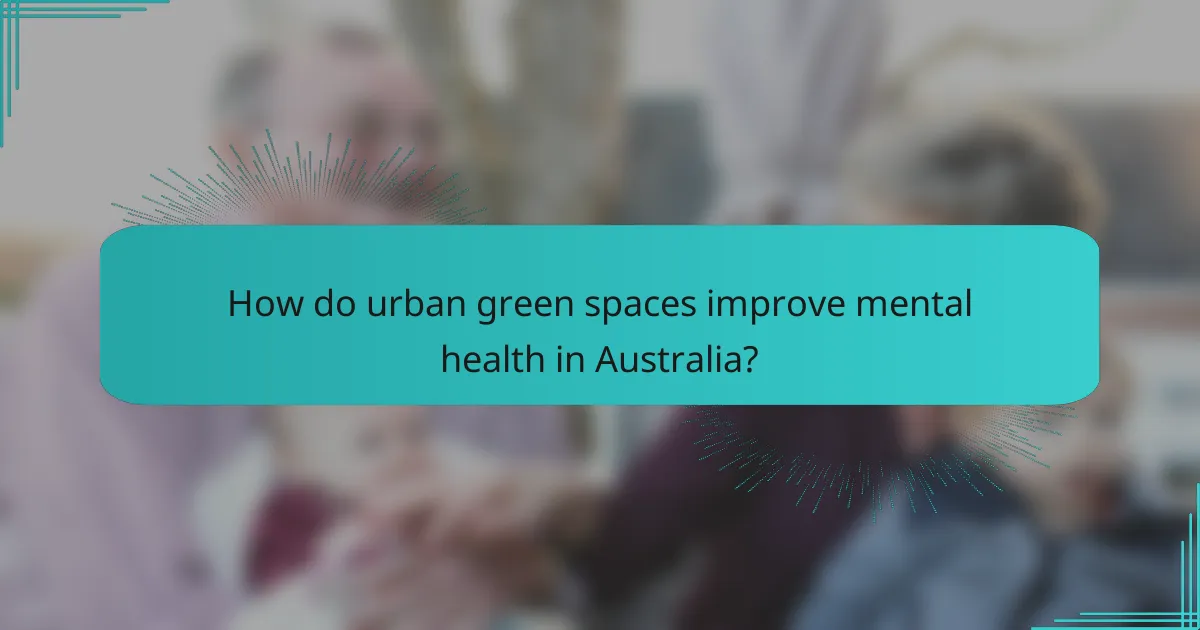
How do urban green spaces improve mental health in Australia?
Urban green spaces significantly enhance mental health in Australia by providing environments that reduce stress, promote physical activity, and foster social connections. These areas serve as vital resources for individuals seeking relief from the pressures of urban life, contributing to overall well-being.
Reduction of stress and anxiety
Access to urban green spaces can lower levels of stress and anxiety. Natural environments have a calming effect, helping individuals to unwind and escape the hustle and bustle of city life. Studies suggest that spending time in parks or gardens can lead to noticeable reductions in cortisol levels, a hormone associated with stress.
To maximize these benefits, individuals should aim to spend at least 20-30 minutes in green spaces daily. Simple activities like walking, reading, or meditating in these areas can significantly enhance relaxation and mental clarity.
Enhanced mood and well-being
Urban green spaces are linked to improved mood and overall well-being. Exposure to nature can trigger the release of endorphins, which are chemicals in the brain that promote feelings of happiness. Regular visits to parks can lead to a more positive outlook on life.
Engaging in activities like gardening or simply enjoying the scenery can further elevate mood. Incorporating these experiences into a weekly routine can help sustain mental health benefits over time.
Promotion of physical activity
Green spaces encourage physical activity, which is crucial for mental health. Activities such as walking, jogging, or cycling in parks not only improve physical fitness but also contribute to better mental health outcomes. Regular exercise is known to reduce symptoms of depression and anxiety.
To make the most of urban green spaces, consider setting specific goals for physical activity, such as participating in a weekly group walk or joining a local sports club that utilizes these areas. This can help create a consistent routine that benefits both physical and mental health.
Social interaction opportunities
Urban green spaces provide valuable opportunities for social interaction, which is essential for mental well-being. Parks and community gardens often serve as gathering spots where people can connect, share experiences, and build relationships. These social ties can enhance feelings of belonging and support.
To foster social connections, individuals can participate in community events or volunteer programs in local green spaces. Engaging with others in these settings can lead to lasting friendships and a stronger sense of community, further supporting mental health.

What biodiversity benefits do urban green spaces provide?
Urban green spaces play a crucial role in enhancing biodiversity by offering habitats for various species, supporting pollinators, and improving air quality. These benefits contribute to healthier ecosystems and more resilient urban environments.
Habitat for native species
Urban green spaces serve as essential habitats for native species, including birds, insects, and small mammals. By incorporating native plants, these areas provide food and shelter, helping to sustain local wildlife populations. Creating diverse plantings can attract a wider range of species, enhancing the overall ecological balance.
To maximize habitat benefits, consider planting a mix of trees, shrubs, and flowers that are indigenous to the region. This not only supports local fauna but also reduces maintenance needs, as native plants are typically more resilient to local pests and climate conditions.
Pollinator support
Urban green spaces are vital for supporting pollinators such as bees, butterflies, and other insects. These species are crucial for the pollination of many plants, including those that provide food for humans. By planting a variety of flowering plants that bloom at different times, urban areas can create a continuous food source for pollinators throughout the growing season.
To enhance pollinator support, avoid using pesticides and consider establishing pollinator gardens that feature native flowering plants. Simple actions like providing water sources and shelter can further encourage these beneficial insects to thrive in urban environments.
Improved air quality
Urban green spaces contribute significantly to improved air quality by filtering pollutants and absorbing carbon dioxide. Trees and plants act as natural air purifiers, reducing levels of harmful substances and providing cleaner air for city residents. This is especially important in densely populated areas where air pollution can be a major health concern.
To maximize air quality benefits, maintain a healthy canopy cover by planting a variety of tree species. Aim for a mix of deciduous and evergreen trees to ensure year-round coverage, which can help mitigate urban heat and improve overall environmental conditions.
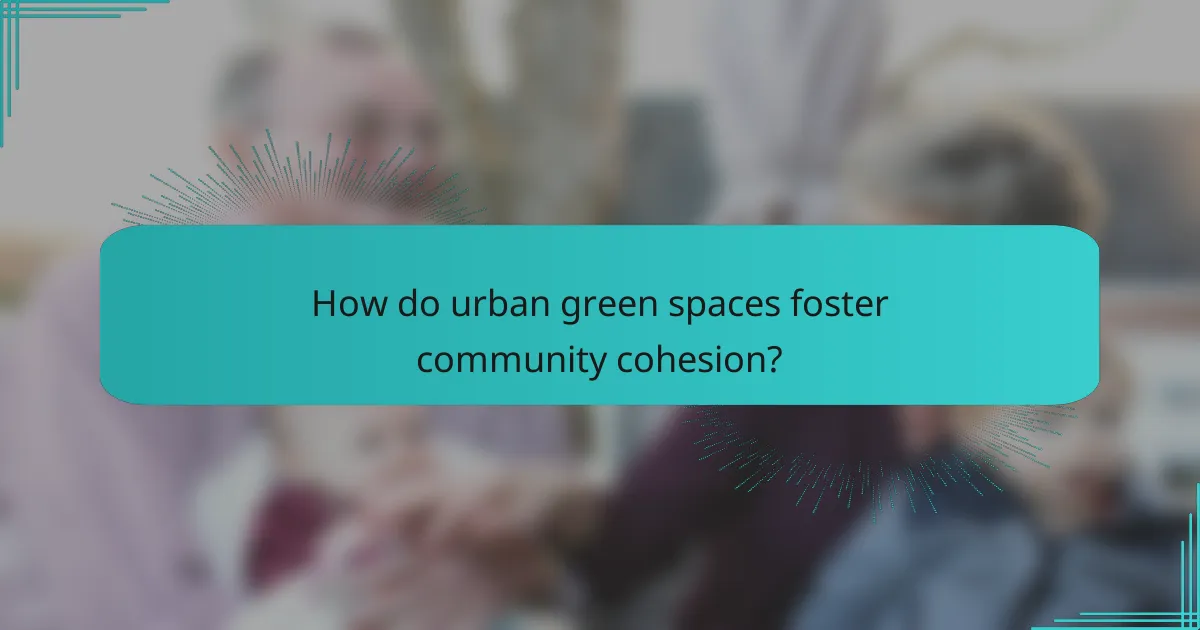
How do urban green spaces foster community cohesion?
Urban green spaces play a vital role in fostering community cohesion by providing areas where residents can connect, interact, and collaborate. These spaces encourage social interactions and create a sense of belonging among community members.
Spaces for social gatherings
Green spaces serve as essential venues for social gatherings, allowing residents to come together for various activities. Parks, gardens, and community fields can host picnics, barbecues, and informal meet-ups, which help strengthen relationships among neighbors.
For effective social gatherings, consider providing amenities like benches, tables, and shade. These features can enhance comfort and encourage more frequent use of the space.
Encouragement of local events
Urban green spaces often act as hubs for local events, such as farmers’ markets, concerts, and festivals. These events not only draw people from different backgrounds but also promote local businesses and artisans.
To maximize participation, communities can collaborate with local organizations to plan events that cater to diverse interests. Offering a mix of activities, such as workshops and performances, can attract a wider audience.
Strengthening neighborhood ties
Regular use of green spaces helps strengthen neighborhood ties by creating opportunities for residents to interact in a relaxed environment. Shared experiences in these areas foster trust and camaraderie among community members.
Encouraging volunteer initiatives, such as community gardening or clean-up days, can further enhance these connections. These activities not only beautify the space but also instill a sense of ownership and pride among residents.

What criteria should be considered when designing urban green spaces?
When designing urban green spaces, key criteria include accessibility, integration with existing infrastructure, and environmental sustainability. These factors ensure that green spaces are functional, inclusive, and beneficial to both the community and the environment.
Accessibility for all demographics
Accessibility is crucial for ensuring that urban green spaces can be enjoyed by everyone, regardless of age, ability, or socioeconomic status. Design features such as wheelchair ramps, wide pathways, and seating areas can enhance usability for all visitors.
Consider implementing sensory gardens for individuals with sensory processing challenges, and ensure that spaces are well-lit and safe for evening use. Engaging with community members during the planning phase can help identify specific needs and preferences.
Integration with existing infrastructure
Integrating green spaces with existing urban infrastructure can create seamless transitions between natural and built environments. This might involve connecting parks to public transportation, bike lanes, and pedestrian pathways, making them more accessible and encouraging their use.
Utilizing vacant lots or underused areas for green space can revitalize neighborhoods while complementing existing structures. Collaboration with local businesses and city planners can facilitate this integration effectively.
Environmental sustainability practices
Incorporating environmental sustainability into the design of urban green spaces is essential for long-term viability. This includes using native plants that require less water and maintenance, as well as implementing rain gardens to manage stormwater runoff.
Consideration of sustainable materials for pathways and furniture, along with practices like composting and recycling, can further enhance the ecological footprint of these spaces. Regular maintenance and community involvement can ensure that these practices are upheld over time.

What are the emerging trends in urban green space development?
Emerging trends in urban green space development focus on enhancing mental health, supporting biodiversity, and fostering community cohesion. Innovations such as vertical gardens and green roofs are becoming increasingly popular as cities seek to integrate nature into densely populated areas.
Vertical gardens in urban areas
Vertical gardens, also known as living walls, are becoming a significant trend in urban green space development. These installations utilize vertical surfaces to grow plants, which can improve air quality, reduce noise pollution, and enhance aesthetic appeal in urban settings.
When considering vertical gardens, it’s essential to evaluate factors such as sunlight exposure, irrigation systems, and plant selection. Common choices include hardy species like ferns, succulents, and flowering plants that thrive in limited soil depth.
To successfully implement a vertical garden, start by assessing the wall’s structure and ensuring it can support the weight of the plants and soil. Regular maintenance, including watering and pruning, is crucial for sustaining the garden’s health and appearance.
